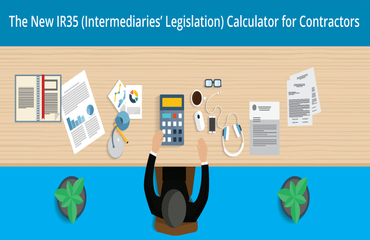The New IR35 - Intermediaries' Legislation Calculator for Contractors
Article Author: Sumit Agarwal Posted on: December 13, 2016 (Full Author Bio in the box on the right side) 3890 views
3890 views

As a contractor, you will be aware of IR35 and know that recently HMRC have promoted more or less the same “intermediaries’ legislation” targeted specifically at public sector contractors. You will already know that if you provide your services through a limited company it is essential to protect yourself by ensuring that you operate outside IR35 legislation. HMRC’s most recent warning is clear: if it’s suspected your limited company (PSC) is disguising an employee‒employer relationship with your client, if you are unable to provide evidence to the contrary and thus fall inside the legislation, that will mean you should have been drawing a salary through your client’s PAYE system, and:
There can be significant consequences if you, your intermediary, or client ignore IR35 legislation. Interest and penalties can be charged on any extra tax and National Insurance contributions that are owed. Penalties can be more severe if it can be proved that IR35 rules or legislation have been deliberately ignored.
The new “Off-payroll working in the public sector: reform of the intermediaries’ legislation”, published in May 2016, proposes giving the engager “more of a role” in helping to ensure compliance. Understandably, this has made potential engagers / HR departments in the public sector highly nervous, “because HR will be responsible for ensuring that contractors are genuinely in business of their own account and engagers could face penalties if contractors subsequently turn out to be disguised employees.”
Where does this leave contractors in the public sector and generally?
The new regime will apply to end-users in the public sector from April 2017, but many think it is likely that in the not too distant future it will be extended to private-sector hirers as well. The government seems deaf to the concerns that have been raised across the board; the main worry is that HR departments in the public sector will automatically now enrol contractors on to their PAYE system to protect their own backs. But the affects don’t stop there, as this will probably mean that contractors will be forced to raise rates to cover their costs for being taxed at source or will be reluctant to work within the public sector. Note also that the Autumn Statement confirmed that the 5% “intermediary expenses” “to cover the costs of running a business”, in addition to the normal expenses contractors can claim, can no longer be claimed by contractors working in the public sector.
While the IR35 root of this legislation for public sector contractors remains, there is a change of emphasis now. Where once emphasis was on control (supervision direction or control (SDC)), now emphasis seems to be on the substitution clause; and where once the number of hours you worked for a particular client counted (less or no more than 20 per cent of the time), in the recent HMRC example, the substitution clause seems to override that too. The poor contractor in the example below, Christine, who works in the public sector, sees that her employment status is calculated (not in her favour) by her inability to “substitute”.
Below is most of the HMRC example from the recently published reform document. It goes some way to illustrate the decision-making process HMRC suggests public sector employers use in order to calculate the employment status of contractors:
Christine’s story (based on HMRC’s example)
A local authority needs cover for three months maternity leave – possibly longer. Christine is a retired social worker and agrees with the HR Manager to provide locum cover through her PSC. She is highly skilled and needs little day-to-day support. HR draws up a contract with Christine’s PSC, which sets out what she must do in her role:
- Report to the senior social worker on the team
- Obtain legal sign-off on certain decisions
- Follow the governance guidelines
- Work cases as directed
Christine is to be paid a daily rate and her contract is terminable at one week’s notice. Now, using HMRC’s guide, the engager should come to a decision about whether the rules of the new legislation apply, and how to deal with payments to Christine.
1. First of all the gateway process using the HMRC online tool to see if the rules apply:
- Is the public sector the engager – [yes]
- Are they hiring through an agency? – [no]
- Is 20% or more of the worker’s contract for materials used? – [no]
- Does the worker own their own company? – [yes]
The result achieved is that the engager “needs to consider further tests”; the two “yes” replies relating to the engager and the contractor trigger the next step of the process.
2. The HR department considers the second part of the process
- Christine cannot in practice send a substitute because of case sensitivity;
- There are some strong elements of control in the contract (see top).
The result achieved now is that “Christine is in scope”; she would be unlikely to be able to send a substitute, because of case sensitivity; and, because of the nature of the work, there are elements of control in her contract that cannot be ignored (see top of this box), which points to the engagement as “employment”.
Note that the “right to substitution” clause in your contract will only be accepted by HMRC if it is genuine, and HMRC is unlikely to accept that the right exists if the client’s permission must be obtained before sending a substitute.
3. The online tool shows that the new rules apply and the local authority has to operate PAYE “as though” Christine was employed directly by them.
4. A contract is drawn up with Christine’s PSC.
5. Christine must be paid through PAYE.
6. HR sets Christine up on its payroll and goes through the RTI process as follows:
- Monthly payments to the PSC reported to HMRC on or before the payment date.
- The tax/NI deductions paid by the 19th or the 22nd the following month.
- The local authority also pays employers’ NI as secondary contributor through RTI.
7. HMRC receives the tax and National Insurance.
8. Christine can take a salary or dividends from her PSC; offsetting is required to make sure tax and NI are not paid twice.
Remember that the three main tests to determine whether you are inside IR35 or outside are:
1. Control: a worker is not an employee unless there is a right to exercise control over her or him. This could be a right to control what work is done, where or when it is done, or how it is done. The right of control is the important issue and not the actual control.
2. The right to substitution, you can get a substitute or assistant to do the job: personal service is an essential element of an employment contract. A self-employed person has the freedom to choose whether to do the job herself or hire someone else to do it for him or her; s/he may hire someone else to provide substantial help.
3. Mutuality of obligation: there should be various mutual obligations within the contract. The obligation to perform and to be paid would form part of any contract – but the mutual obligations needed for a contract of employment consist of more than this, there needs to be obligation to offer, and an obligation to accept, future work. There are other factors also, please see here.
The conclusion, bearing in mind the case of Christine is this, that the right of substitution is the ultimate factor. However, the dynamic between limited company contractors and their public sector clients has totally changed. Now, instead of the contractor deciding on their IR35 status, it will make the engager responsible for taxing the contractor’s income at source if they believe that the contractor’s business falls outside the new rules. The fear is that because public sector organisations will understandably be extremely risk-averse, most public sector contractors working through PSCs will be deemed to fall inside the legislation, which means they will be taxed at source.
What should contractors do?
Whether you work inside or outside, often or not so often, for the public sector, or the private sector, make sure every contract you sign with a client is checked by an expert. Take out tax investigation insurance. Make sure that every contract includes the clause about substitution and that it is worded correctly to ensure any substitution right is valid ‒ it must be unfettered and you must pay the substitute yourself. And if you then exercise the right it’s impossible for HMRC to prove personal service exists ‒ which means you can never be a disguised employee and therefore you will fall outside IR35. Why not take the IR35 test and, depending on your score, Professional Contractor Accountant will help you negotiate the legislation from there.
Latest Posts
-

Staying HMRC Compliant: VAT Returns Have Chan...
by Amanda Swales on January 29, 2020 Accounting & Tax -

Self Assessment Tax Return 101 - Filling In T...
by Amanda Swales on January 15, 2020 Accounting & Tax -

-



 Five Good Reasons Why Running A Limited Company Benefits Contractors
Five Good Reasons Why Running A Limited Company Benefits Contractors  How good are Recruiters at matching Contractor skills to roles
How good are Recruiters at matching Contractor skills to roles  Considerations When Outsourcing Your Payroll
Considerations When Outsourcing Your Payroll  Recruitment Outsourcing Why Are Recruiters Unreliable
Recruitment Outsourcing Why Are Recruiters Unreliable  5 Things Every Recruiter Should Do
5 Things Every Recruiter Should Do  Brexit and the insolvency sector
Brexit and the insolvency sector  The New IR35 - Intermediaries' Legislation Calculator for Contractors
The New IR35 - Intermediaries' Legislation Calculator for Contractors  Would you like your family to maintain their lifestyle should the worst happen to you
Would you like your family to maintain their lifestyle should the worst happen to you  Amazing Social Media Facts, Statistics and Figures for 2013
Amazing Social Media Facts, Statistics and Figures for 2013  Travel and the 2 year rule for Contractors
Travel and the 2 year rule for Contractors  Why Grammarly is a must have tool for Businesses and Website SEO?
Why Grammarly is a must have tool for Businesses and Website SEO?  Choosing the right bank for your limited company
Choosing the right bank for your limited company  10 Best and Essential WordPress Plugins for Small Business Websites
10 Best and Essential WordPress Plugins for Small Business Websites  KickAss Torrents files a petition to free Artem Vaulin
KickAss Torrents files a petition to free Artem Vaulin  Why Google My Business is an essential tool for Small Businesses?
Why Google My Business is an essential tool for Small Businesses?  Keeping Your Social Media Content Appropriate
Keeping Your Social Media Content Appropriate  Acronyms to increase efficiency in the workplace
Acronyms to increase efficiency in the workplace  How to create a productive home office space
How to create a productive home office space  Free Must Have SEO and Social Media Tools for Small Businesses
Free Must Have SEO and Social Media Tools for Small Businesses 

